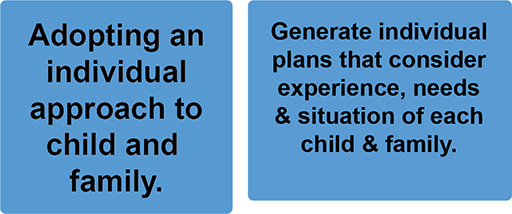3 Adopting an individual approach
To deliver effective pain management to a child there is a need to recognise their individuality, which in turn warrants an individual approach to addressing how to relieve their pain. Many studies have focussed on this approach. Tailored or individualised pain management for children needs to encompass tailored analgesic medication (Lundeberg 2015) as well as non-pharmacological approaches, and managing anxiety and pain (Gai et al 2020; Fortier and Kain 2015).
When asked about taking individual approach to a child and family in relation to managing a child’s pain HCPs reported that: ‘everyone’s different, every family is different and every social circumstance is different’.
Most practitioners agreed that an individual approach was an important aspect of managing children’s pain, acknowledging that: ‘it should be paramount in all aspects of care, but certainly within pain management’.
You will remember that in section two we covered the need to provide guidance and protocols to support effective pain management. But as one size doesn’t fit all, such an approach could be deemed to be the opposite of managing a child’s pain through an individualised approach. However, practitioners who were asked about individualised care were clear that this should not be the case.
It was reported that even when working with a protocol, ‘tailoring it to that child or family’ was important, meaning that flexibility was important: ‘We won’t rigidly stick with a regime just because that’s the regime that we do for X. So, I think we’re quite flexible.’
This level of flexibility being reported here may come with experience, as these responses came from pain specialist practitioners.
A pain nurse stated the following: ‘we have a plan there. But within the plan there could be plan A, B and C depending on the individual child’.
Participants talked of the importance of both ‘involving them (child and family) in the conversations at the bedside’ and treating the ‘family as a whole, making sure that they have plenty of information so that they know what to expect’.

